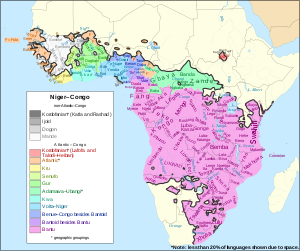Atlantic–Congo languages
| Atlantic–Congo | |
|---|---|
| Geographic distribution | Africa |
| Linguistic classification | Niger–Congo?
|
| Subdivisions |
|
| ISO 639-5 | alv |
| Glottolog | atla1278 |
 The Atlantic–Congo languages shown within the Niger–Congo language family. Non-Atlantic–Congo languages are greyscale. | |
The Atlantic–Congo languages are the largest demonstrated family of languages in Africa. They have characteristic
Niger–Congo family hypothesis. They comprise all of Niger–Congo apart from Mande, Dogon, Ijoid, Siamou, Kru, the Katla and Rashad languages (previously classified as Kordofanian), and perhaps some or all of the Ubangian languages. Hans Günther Mukarovsky's "Western Nigritic" corresponded roughly to modern Atlantic–Congo.[1]
In the infobox, the languages which appear to be the most divergent are placed at the top..
In addition, Güldemann (2018) lists Nalu and Rio Nunez as unclassified languages within Niger-Congo.[3]
There are a few poorly attested languages, such as Bayot and Bung, which may prove to be additional branches.[citation needed]
Comparative vocabulary
Sample basic vocabulary for reconstructed proto-languages of different Atlantic-Congo branches:
| Branch | Language | eye | ear | nose | tooth | tongue | mouth | blood | bone | tree | water | eat | name |
|---|---|---|---|---|---|---|---|---|---|---|---|---|---|
| "Western Nigritic" (roughly Atlantic–Congo) |
Proto-"Western Nigritic"[1] | *-nín-, *-nínu | *-thúi, *-thú- | *-míl-, *-míla | *-nín- (*-níghin-) | *-líma (*-líami); *-lélum- (*-lúm-) | *-níana; *-níuna (*-núa) | *-ghìá; *-kàl- | *-khwúpà | *-tí | *-lingi | *di- | *-ghínà |
| Benue-Congo | Proto- Benue-Congo[4] |
*-lito | *-tuŋi | *-zua | *-nini, *-nino; *-sana; *-gaŋgo | *-lemi; *-lake | *-zi; *-luŋ | *-kupe | *-titi; *-kwon | *-izi; *-ni | *-zina | ||
| Bantu | Proto-Bantu[5] | *i=jíco | *kʊ=tʊ́i | *i=jʊ́lʊ | *i=jíno; *i=gego | *lʊ=lɪ́mi | *ka=nʊa; *mʊ=lomo | *ma=gilá; *=gil-a; *ma=gadí; *=gadí; *mʊ=lopa; *ma=ɲínga | *i=kúpa | *mʊ=tɪ́ | *ma=jíjɪ; *i=diba (HH?) | *=lɪ́ -a | *i=jína |
| Yoruboid | Proto-Yoruboid language[6] | *é-jú | *é-tí | *ímṵ́ | *éŋḭ́ | Yor. ahá̰ | *ɛ́lṵ ? | *ɛ̀-gyɛ̀ | *égbṵ́gbṵ́ | Yor. igi | *ó-mḭ | *jɛṵ | *órú- ? |
| Gbe | Proto-Gbe[7] | *-tó | *aɖú | *-ɖɛ́ | *-ɖũ; *-ɖũkpá | *-ʁʷũ | *-χʷú | *-tĩ́ | *-tsĩ | *ɖu | *yĩ́kɔ́ | ||
| Gur | Proto- Central Gur[8] |
*me (Oti-Volta, Gurunsi) | *ye (Gurunsi, Kurumfe) | *ñam, *ñim (Oti-Volta, Kurumfe) | *ʔob, *ʔo | *tɪ (Oti-Volta, Gurunsi) | *ni, *ne; *nã (Oti-Volta, Gurunsi) | *di | *yɪɗ, *yɪd (Oti-Volta, Gurunsi) | ||||
| Gbaya | Proto-Gbaya[9] | *gbà.l̥í/l̥í | *zɛ̀rà | *zɔ̰̀p | *ɲín | *léɓé ~ lémbè | *nú | *tɔ̀k | *gbà̰là̰ | *l̥ì | *tè | *ɲɔŋ/l̥i | *l̥ín ~ l̥íŋ |
References
- ^ OCLC 21527702.
- ^ Blench, Roger. "Niger-Congo: an alternative view" (PDF). Archived from the original (PDF) on 2023-04-05.
- S2CID 133888593.
- ISBN 9783110905311.
- ISBN 978-0-700-71134-5.
- ^ Aubry, N.; Friedman, H.; Pozdniakov, K. (2004). "Proto-Yoruba-Igala Swadesh list" (PDF). Langage, Langues et Cultures d’Afrique (LLACAN), Centre National de la Récherche Sciéntifique (CNRS). Archived from the original (PDF) on 2021-01-05.
- ISBN 978-3-11-013392-9.
- ISBN 2852970635.
- ISBN 9782705303532.
